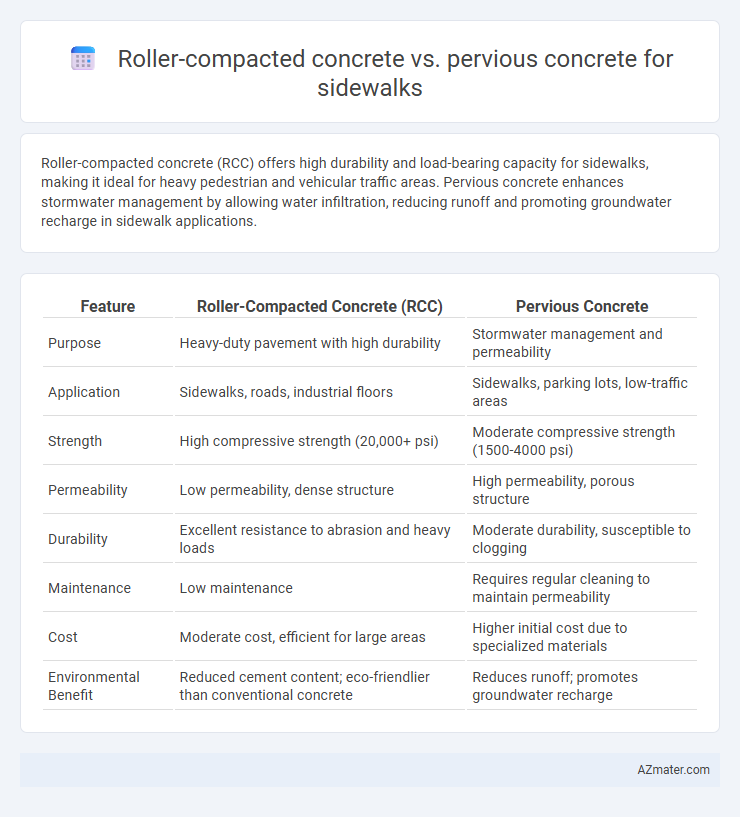Roller-compacted concrete (RCC) offers high durability and load-bearing capacity for sidewalks, making it ideal for heavy pedestrian and vehicular traffic areas. Pervious concrete enhances stormwater management by allowing water infiltration, reducing runoff and promoting groundwater recharge in sidewalk applications.
Table of Comparison
| Feature | Roller-Compacted Concrete (RCC) | Pervious Concrete |
|---|---|---|
| Purpose | Heavy-duty pavement with high durability | Stormwater management and permeability |
| Application | Sidewalks, roads, industrial floors | Sidewalks, parking lots, low-traffic areas |
| Strength | High compressive strength (20,000+ psi) | Moderate compressive strength (1500-4000 psi) |
| Permeability | Low permeability, dense structure | High permeability, porous structure |
| Durability | Excellent resistance to abrasion and heavy loads | Moderate durability, susceptible to clogging |
| Maintenance | Low maintenance | Requires regular cleaning to maintain permeability |
| Cost | Moderate cost, efficient for large areas | Higher initial cost due to specialized materials |
| Environmental Benefit | Reduced cement content; eco-friendlier than conventional concrete | Reduces runoff; promotes groundwater recharge |
Introduction to Modern Sidewalk Solutions
Roller-compacted concrete (RCC) offers high durability and rapid construction for modern sidewalks, making it ideal for heavy pedestrian and light vehicle traffic areas. Pervious concrete enhances stormwater management by allowing water infiltration, reducing runoff and promoting groundwater recharge in urban environments. Selecting between RCC and pervious concrete depends on specific site requirements such as load-bearing capacity and environmental sustainability goals.
What is Roller-Compacted Concrete?
Roller-compacted concrete (RCC) is a dry mix concrete placed with paving equipment and compacted by vibratory rollers, offering high strength and durability ideal for sidewalks subjected to heavy traffic. RCC provides a dense, low-permeability surface that resists deformation and requires less curing time compared to traditional concrete, enhancing construction efficiency. Unlike pervious concrete, RCC prioritizes load-bearing capacity over water permeability, making it suitable for sidewalks needing robust structural support.
What is Pervious Concrete?
Pervious concrete is a highly porous material designed to allow water to pass through, reducing surface runoff and promoting groundwater recharge. Unlike roller-compacted concrete, which is dense and compacted for heavy-load applications, pervious concrete consists of a network of interconnected voids that facilitate rapid drainage, making it ideal for eco-friendly sidewalk construction. This permeability helps manage stormwater, minimizes puddling, and supports sustainable urban drainage systems.
Strength and Durability Comparison
Roller-compacted concrete (RCC) offers superior compressive strength, typically exceeding 25 MPa, making it ideal for high-load sidewalk applications, while pervious concrete generally ranges between 10-20 MPa due to its porosity. RCC's dense matrix enhances durability by providing excellent resistance to abrasion, freeze-thaw cycles, and chemical attack compared to pervious concrete, which can be more susceptible to clogging and reduced strength over time. The lower permeability of RCC contributes to its longevity in heavy-traffic environments, whereas pervious concrete excels in stormwater management but requires more maintenance to sustain durability under mechanical stress.
Permeability and Drainage Capabilities
Pervious concrete offers superior permeability and drainage capabilities compared to roller-compacted concrete, allowing water to pass through its porous structure and reducing surface runoff on sidewalks. Roller-compacted concrete has a dense composition with low permeability, making it less effective in managing stormwater but providing higher durability and load-bearing strength. Selecting pervious concrete enhances pedestrian safety by minimizing standing water and improving groundwater recharge in urban sidewalk applications.
Installation Process and Construction Time
Roller-compacted concrete (RCC) features a dry mix installed using heavy rollers and vibratory compactors, allowing rapid placement with minimal formwork, significantly reducing construction time on sidewalks. Pervious concrete requires careful mixing to maintain high porosity, and its installation involves precise grading and curing to preserve permeability, which can extend the construction timeline compared to RCC. The dense compaction of RCC ensures faster load-bearing capacity, making it ideal for quick sidewalk projects, whereas pervious concrete demands more meticulous handling for environmental benefits like stormwater management.
Maintenance Needs and Longevity
Roller-compacted concrete (RCC) offers high durability and low maintenance due to its dense composition, making it resistant to heavy traffic and weathering, which significantly extends sidewalk lifespan. Pervious concrete, designed for effective stormwater drainage, requires frequent cleaning to prevent clogging and maintain permeability, increasing maintenance efforts over time. While RCC provides superior longevity with minimal upkeep, pervious concrete demands more regular maintenance to preserve its functional benefits.
Environmental Impact and Sustainability
Roller-compacted concrete (RCC) offers high durability and low permeability, reducing maintenance needs and thus environmental resource consumption over time, while pervious concrete enhances stormwater management by allowing water infiltration, mitigating runoff, and replenishing groundwater. RCC's dense structure limits pollutant penetration and erosion, contributing to sustainable infrastructure longevity, whereas pervious concrete's open-graded matrix supports urban sustainability through natural water filtration and reduced heat island effects. Selecting between RCC and pervious concrete for sidewalks involves balancing RCC's robustness and low lifecycle emissions with pervious concrete's ecological benefits in managing urban water cycles and promoting groundwater recharge.
Cost Analysis and Economic Benefits
Roller-compacted concrete (RCC) offers lower installation costs due to its faster placement and minimal finishing requirements, making it economically beneficial for large sidewalk projects. Pervious concrete, while generally more expensive upfront because of specialized materials and construction techniques, provides long-term savings through enhanced stormwater management and reduced runoff treatment expenses. Evaluating lifecycle costs, RCC is cost-effective for durability and speed, whereas pervious concrete adds value by mitigating environmental impacts and potential municipal fees related to stormwater control.
Best Applications: Choosing the Right Concrete for Sidewalks
Roller-compacted concrete (RCC) is best suited for high-traffic sidewalks needing exceptional strength and durability due to its dense, compacted structure. Pervious concrete excels in applications requiring superior stormwater management and environmental benefits, allowing water infiltration to reduce runoff and promote groundwater recharge. Selecting between RCC and pervious concrete depends on factors like load requirements, drainage needs, and sustainability goals for sidewalk projects.

Infographic: Roller-compacted concrete vs Pervious concrete for Sidewalk
 azmater.com
azmater.com